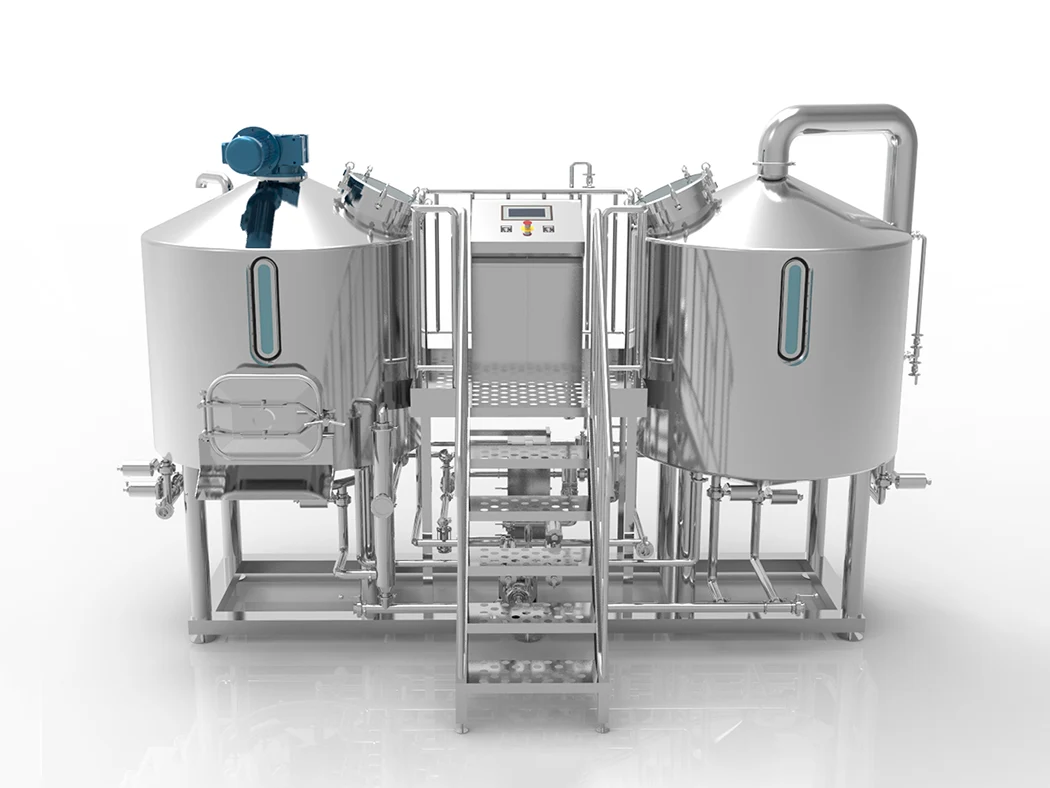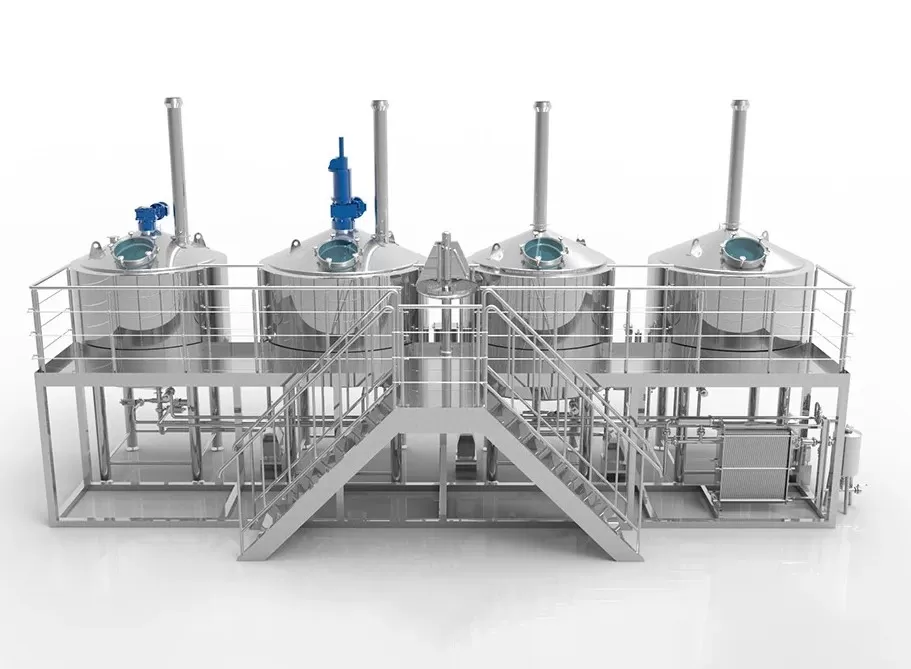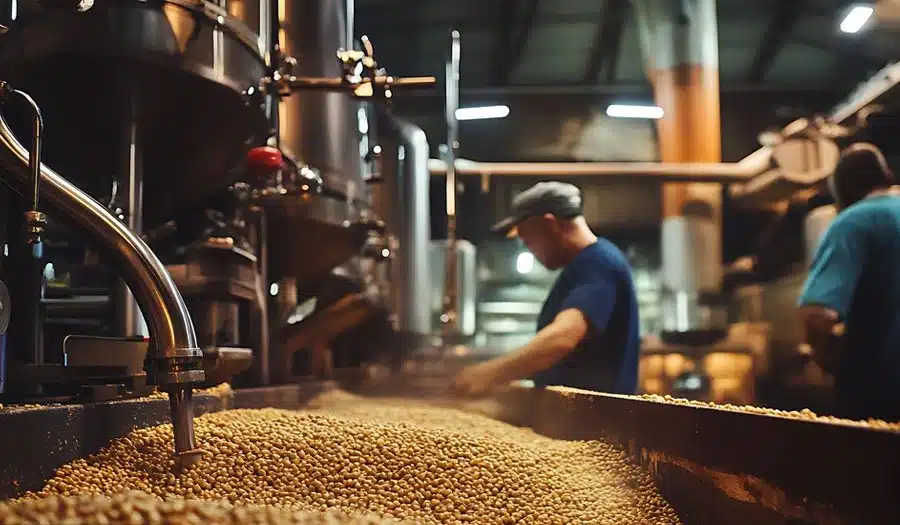Beer, one of the most popular alcoholic beverages worldwide, has undergone centuries of evolution in brewing. Modern industrial beer production is no longer a manual craft but a fully automated and standardized system. Starting from wort preparation, the process involves mashing, fermentation, filtration, cleaning, and finally bottling—each step is backed by specialized equipment to ensure beer quality and production efficiency.
Mashing System
The mashing system is the starting point of beer brewing. Its main function is to break down starches and proteins in the malt into fermentable sugars and flavorful substances through the action of heat and enzymes, ultimately forming wort. This system is technically complex and one of the most energy-intensive parts of the process.
Main Components:
- Malt Mill: Crushes dried malt to increase surface area for mashing.
- Mash Tun: Mix malt and water and heat the mixture.
- Lauter Tun: Separates wort from spent grains.
- Kettle: Boils the wort for sterilization and hop addition.
- Whirlpool: Uses centrifugal force to remove protein coagulates and impurities.
System Features:
- Multi-point temperature control with automatic stirring.
- Equipped with level indicators and heat recovery systems.
- The control module supports recipe input and traceability.
- The quality of the mashing system directly affects water quality, laying the foundation for the final beer flavor.
발효 시스템
The fermentation system is the “core processing area” of brewing, where biochemical transformation occurs. After mashing and cooling, the wort is inoculated with yeast here to produce alcohol, CO₂, and various flavor compounds.
Main Components:
- Fermenter: Sealed, temperature-controlled pressure vessel.
- Brite Tank: Used for beer conditioning and CO₂
- Temperature and Cooling System: Includes plate heat exchangers and chillers.
- Yeast Handling System: Enables efficient yeast dosing and recovery.
System Features:
- Conical bottom design for easy yeast removal.
- Independent temperature control and CO₂ exhaust for each tank.
- Automated yeast recovery improves utilization efficiency.
CIP(클린-인-플레이스) 시스템
CIP systems play a vital role in industrial brewing by ensuring safe and efficient internal cleaning and sterilization without equipment disassembly. This is fundamental for food safety and equipment longevity.
Main Components:
- Caustic tank, acid tank, and water tank.
- Cleaning pump set and return system.
- Water heater and condenser.
- Internal spray balls for each tank.
System Features:
- Fully automated control for time, concentration, and temperature.
- Real-time monitoring of flow rate, pH, and temperature.
- Seamlessly integrated with fermenters, mash tuns, and packaging lines for one-click cleaning.
Filling & Packaging System
After fermentation, maturation, and conditioning, beer enters the filling line—the final product stage. The stability and efficiency of this system directly affect product quality and production capacity.
Main Components:
- Filler: Supports bottles, cans, and kegs.
- Capper: Compatible with various bottleneck types.
- Labeler: Applies brand, ingredient, and anti-counterfeit labels.
- Packaging Conveyor Line: Handles packing, boxing, and stacking.
System Features:
- Uses vacuum or isobaric filling methods.
- CO₂ purging reduces oxidation.
- Supports in-line weight checks, leakage detection, and automatic rejection.
Detailed Brewing Process
매싱 & 라우터링
Mashing converts starch into fermentable sugars using enzymes:
- Malt Mill: Crushes malt to enhance mashing efficiency.
- Mash Tun: Mixes and heat malt with hot water to activate enzymes.
- Lauter Tun: Filters mash into clear wort.
- Kettle: Boils wort and adds hops for aroma and bitterness.
- Whirlpool: Removes protein coagulates and hop residues.
발효
After boiling, the wort is cooled to yeast fermentation temperature (8–22°C):
- Plate Heat Exchanger: Rapidly cools the wort.
- Fermenter: Yeast inoculated for fermentation in a sealed environment.
- Conical Bottom: Facilitates yeast and sediment removal.
CIP 클리닝 시스템
Hygiene is vital in the food and beverage industries. The CIP system cleans internal surfaces without disassembly:
- Acid & Caustic Tanks
- Cleaning Pumps & Pipelines
- Spray Balls
Filling & Packaging Process
Once fermentation and storage are complete, beer proceeds to packaging:
- Brite Tank: Adjusts carbonation and stores beer.
- Filler: Automatically fills bottles, cans, or kegs.
- Capping & Labeling
- Packing Line: Handles packaging and conveyance.
Brewing Line Configuration Table
|
장비 이름 |
기능 |
Typical Capacity |
참고 사항 |
|
몰트 밀 |
Malt crushing |
300–1000 kg/h |
Adjustable crushing fineness |
|
매시 툰 |
Mashing & enzyme activation |
5HL–50HL |
Stirring and temperature control |
|
라우터 툰 |
Wort filtration |
Same as Mash Tun |
With false bottom & lifting arms |
|
끓는 주전자 |
Wort boiling & hop addition |
5HL–50HL |
Stainless steel + steam heating |
|
소용돌이 |
Residue separation |
5HL–50HL |
Bottom sediment outlet |
|
Plate Heat Exchanger |
Wort cooling |
5–20 m² |
Multi-stage heat exchange |
|
발효기 |
발효 |
5HL–100HL |
With temp control & CO₂ release |
|
브라이트 탱크 |
최종 컨디셔닝 |
5HL–100HL |
Connects to filling line |
|
냉각기 |
Provides coolant (e.g. glycol) |
2–10 HP |
Controls fermentation/storage temp |
|
CIP Unit |
Automatic cleaning system |
Dual tank + hot water |
Connects to all brewing tanks |
|
필러 |
Bottle/can/keg filling |
500–3000 bph |
Includes rinsing, filling, sealing |
|
Labeling Machine |
Automatic labeling |
500–3000 bph |
Prints QR codes & production info |

Automation & Control Systems
Modern beer brewing heavily relies on automation for efficiency and consistency. Using PLCs (Programmable Logic Controllers), sensors, actuators, and HMI (Human-Machine Interfaces), brewing systems can precisely control mashing, fermentation, cleaning, and filling. Real-time monitoring of temperature, pressure, liquid levels, and flow ensures accurate recipe execution, automated cleaning, and error alarms—minimizing human error and enhancing productivity. These digital, standardized, and traceable systems are essential for modern breweries.
Advantages of Modular Brewing Line Design
Modular design is a key trend in modern brewing systems. It divides the entire production line into independently operable units (e.g., mashing, fermentation, CIP, filling modules), offering flexibility, scalability, and cost-effectiveness—ideal for craft breweries or businesses expanding in stages.
Key Advantages:
- Scalable and On-Demand Configuration: Businesses can start small (e.g., 5HL mash + 2 fermenters) and scale later as needed.
- Simplified Installation: Pre-assembled modules with standard interfaces reduce onsite setup time by 30%+.
- Easy Maintenance and Upgrades: Modules can be cleaned or upgraded independently, reducing downtime.
- High Space Efficiency: Compact layout fits urban workshops, basements, or container breweries—ideal for startups.
- Standardized Control: Enables consistent quality across batches with unified process parameters.
- Energy-Efficient: Heat recovery systems lower water and energy usage, supporting sustainability.
결론
Beer brewing is not only an art form but also a highly technical and automated industrial process. From the wort kettle to the final bottled product, every step requires precise equipment and workflow. A well-configured, automated brewing system ensures product quality, boosts output, lowers costs, and helps businesses thrive in a competitive market.




